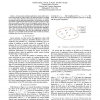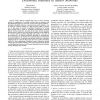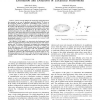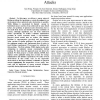94
Voted
IPSN
2005
Springer
15 years 6 months ago
2005
Springer
Abstract—In many sensor networks applications, sensors collect correlated measurements of a physical field, e.g., temperature field in a building or in a data center. However, ...
IPSN
2005
Springer
15 years 6 months ago
2005
Springer
We bound the number of sensors required to achieve a desired level of sensing accuracy in a discrete sensor network application (e.g. distributed detection). We model the state of...
IPSN
2005
Springer
15 years 6 months ago
2005
Springer
— Many inference problems that arise in sensor networks require the computation of a global conclusion that is consistent with local information known to each node. A large class...
IPSN
2005
Springer
15 years 6 months ago
2005
Springer
Abstract— There is widespread agreement that a higher level programming model for sensor networks is needed. A variety of models have been developed, but the community is far fro...
127
Voted
IPSN
2005
Springer
15 years 6 months ago
2005
Springer
Abstract— This paper considers the problem of tracking objects with sparsely located binary sensors. Tracking with a sensor network is a challenging task due to the inaccuracy of...
126
Voted
IPSN
2005
Springer
15 years 6 months ago
2005
Springer
— Sensor networks (SNETs) for monitoring spatial phenomena has emerged as an area of significant practical interest. We focus on the important problem of detection of distribute...
98
Voted
IPSN
2005
Springer
15 years 6 months ago
2005
Springer
A wireless sensor network consists of a large number of small, resource-constrained devices and usually operates in hostile environments that are prone to link and node failures. ...
98
Voted
ICCNMC
2005
Springer
15 years 6 months ago
2005
Springer
Existing approaches for sensor networks suffer from a number of critical drawbacks. First, homogeneous deployments have been commonly assumed, but in practice multiple deployments ...
76
Voted
ICCNMC
2005
Springer
15 years 6 months ago
2005
Springer
— In this paper, we address a sensor network lifetime problem that maintains a certain throughput in an environment where physical node destruction is possible. While lifetime is...
GI
2005
Springer
15 years 6 months ago
2005
Springer
d Abstract) Stefan Lucks1 , Erik Zenner2 , Andr´e Weimerskirch3 , Dirk Westhoff4 1 Theoretische Informatik, University of Mannheim, Germany 2 Erik Zenner, Cryptico A/S, Copenhagen...




